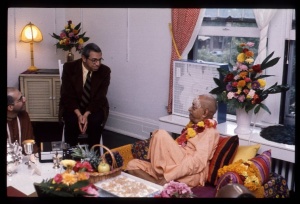CC Madhya 8.161: Difference between revisions
m (1 revision(s)) |
No edit summary |
||
| Line 1: | Line 1: | ||
{{ | [[Category:Sri Caitanya-caritamrta - Madhya-lila Chapter 08|C161]] | ||
<div style="float:left">'''[[Sri Caitanya-caritamrta|Śrī Caitanya-caritāmṛta]] - [[CC Madhya|Madhya-līlā]] - [[CC Madhya 8|Chapter 8: Talks Between Śrī Caitanya Mahāprabhu and Rāmānanda Rāya]]'''</div> | |||
<div style="float:right">[[File:Go-previous.png|link=CC Madhya 8.160|Madhya-līlā 8.160]] '''[[CC Madhya 8.160|Madhya-līlā 8.160]] - [[CC Madhya 8.162|Madhya-līlā 8.162]]''' [[File:Go-next.png|link=CC Madhya 8.162|Madhya-līlā 8.162]]</div> | |||
{{CompareVersions|CC|Madhya 8.161|CC 1975|CC 1996}} | |||
{{RandomImage}} | |||
==== TEXT 161 ==== | ==== TEXT 161 ==== | ||
<div | <div class="verse"> | ||
tayor apy ubhayor madhye | :tayor apy ubhayor madhye | ||
rādhikā sarvathādhikā | :rādhikā sarvathādhikā | ||
mahābhāva-svarūpeyaṁ | :mahābhāva-svarūpeyaṁ | ||
guṇair ativarīyasī | :guṇair ativarīyasī | ||
</div> | </div> | ||
| Line 14: | Line 18: | ||
==== SYNONYMS ==== | ==== SYNONYMS ==== | ||
<div | <div class="synonyms"> | ||
''tayoḥ''—of them; ''api''—even; ''ubhayoḥ''—of both (Candrāvalī and Rādhārāṇī); ''madhye''—in the middle; ''rādhikā''—Śrīmatī Rādhārāṇī; ''sarvathā''—in every way; ''adhikā''—greater; ''mahā-bhāva-svarūpā''—the form of ''mahābhāva''; ''iyam''—this one; ''guṇaiḥ''—with good qualities; ''ativarīyasī''—the best of all. | |||
</div> | </div> | ||
| Line 21: | Line 25: | ||
==== TRANSLATION ==== | ==== TRANSLATION ==== | ||
<div | <div class="translation"> | ||
“‘Among the gopīs of Vṛndāvana, Śrīmatī Rādhārāṇī and another gopī are considered chief. But when we compare the gopīs, it appears that Śrīmatī Rādhārāṇī is most important because Her real feature expresses the highest ecstasy of love. The ecstasy of love experienced by the other gopīs cannot be compared to that of Śrīmatī Rādhārāṇī.’ | “‘Among the gopīs of Vṛndāvana, Śrīmatī Rādhārāṇī and another gopī are considered chief. But when we compare the gopīs, it appears that Śrīmatī Rādhārāṇī is most important because Her real feature expresses the highest ecstasy of love. The ecstasy of love experienced by the other gopīs cannot be compared to that of Śrīmatī Rādhārāṇī.’ | ||
</div> | </div> | ||
| Line 28: | Line 32: | ||
==== PURPORT ==== | ==== PURPORT ==== | ||
<div | <div class="purport"> | ||
This is a quotation from Śrīla Rūpa Gosvāmī’s Ujjvala-nīlamaṇi (Rādhā-prakaraṇa 3). | This is a quotation from Śrīla Rūpa Gosvāmī’s ''Ujjvala-nīlamaṇi'' (''Rādhā-prakaraṇa'' 3). | ||
</div> | </div> | ||
__NOTOC__ | |||
<div style="float:right; clear:both;">[[File:Go-previous.png|link=CC Madhya 8.160|Madhya-līlā 8.160]] '''[[CC Madhya 8.160|Madhya-līlā 8.160]] - [[CC Madhya 8.162|Madhya-līlā 8.162]]''' [[File:Go-next.png|link=CC Madhya 8.162|Madhya-līlā 8.162]]</div> | |||
__NOTOC__ | |||
__NOEDITSECTION__ | |||
Revision as of 10:44, 18 August 2021

A.C. Bhaktivedanta Swami Prabhupada
TEXT 161
- tayor apy ubhayor madhye
- rādhikā sarvathādhikā
- mahābhāva-svarūpeyaṁ
- guṇair ativarīyasī
SYNONYMS
tayoḥ—of them; api—even; ubhayoḥ—of both (Candrāvalī and Rādhārāṇī); madhye—in the middle; rādhikā—Śrīmatī Rādhārāṇī; sarvathā—in every way; adhikā—greater; mahā-bhāva-svarūpā—the form of mahābhāva; iyam—this one; guṇaiḥ—with good qualities; ativarīyasī—the best of all.
TRANSLATION
“‘Among the gopīs of Vṛndāvana, Śrīmatī Rādhārāṇī and another gopī are considered chief. But when we compare the gopīs, it appears that Śrīmatī Rādhārāṇī is most important because Her real feature expresses the highest ecstasy of love. The ecstasy of love experienced by the other gopīs cannot be compared to that of Śrīmatī Rādhārāṇī.’
PURPORT
This is a quotation from Śrīla Rūpa Gosvāmī’s Ujjvala-nīlamaṇi (Rādhā-prakaraṇa 3).